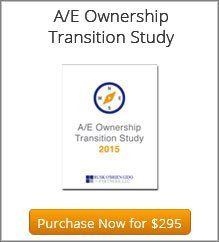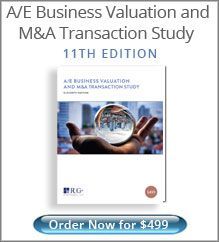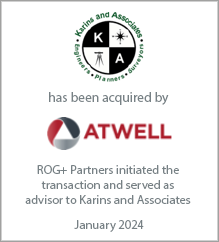With nearly fifteen years of corporate financial advisory experience, Jonathan Voelkel has worked with hundreds of engineering, architecture, and environmental consulting firms across the U.S. and abroad, in all facets of mergers & acquisitions, valuation, ownership transition planning, equity incentive compensation, and ESOP advisory. Jonathan received his Bachelor of Arts (BA) degree in Economics from Johns Hopkins University.
Do the Valuation Multiples You’re Using Actually Apply to Your Firm?
Do the Valuation Multiples You’re Using Actually Apply to Your Firm?
June 19, 2019
In my last Perspective (November 2018), I touched on the importance of why using the “right” level of profit was important when comparing valuations of one’s firm to others on an earnings multiple basis (e.g., 4.2x EBITDA, 3.9x EBIT, etc.). Although there are various levels of profit that firms rely on for quick pricing indications, I focused solely on EBIT (earnings before interest and tax) and EBITDA (earnings before interest, tax, depreciation & amortization) for the sake of simplicity.
This prompted a number of readers to ask for specifics about exactly what the multiple was that they should be using for their firms. Some offered that they were relying on data published in our A/E Business Valuation and M&A Transaction Study, while others were basing their assumptions off of transactions that either they or their peers at other firms had been a part of in the past. As part of my response to these questions, I countered by asking a question of my own: Would you rather your firm be valued by a high or low multiple? The replies were universally consistent: all respondents desired a high multiple.
In actuality though, the greater a firm’s profitability is compared to the profitability of its peer group, the lower the implied multiple, and vice-versa. This probably seems counterintuitive at first thought. After all, why should a firm that’s found a way to deliver enviable profits be subject to a lower multiple, and why should a firm that trails its peers benefit from a higher multiple? The reason is straightforward: The inherent value realizable to an investor lies in that investor’s ability to effect change, change that results in a better-run (more profitable) firm. The value placed on control, as represented by the pricing multiple, should be higher for a firm that isn’t run optimally. On the other hand, investors would balk at paying the same multiple for a median or worse-than-median performing firm, realizing that there is very little they could to that would lead to a positive change of the firm’s performance.
If pricing indications for a group of like firms point to a pre-owner bonus EBITDA of 5.0x, that multiple reflects a result that is applicable to at or around median-performing firms from the perspective of pre-owner bonus EBITDA.
What do I mean by this? Let’s consider three firms, all generating $10 million in net service revenue. Each of the firms can be considered substitutes for one another from the market’s perspective, and the median pre-owner bonus EBITDA for the group to which these firms belong is 12%.
The first firm delivers a profit margin of 12%, meaning that the implied valuation would be $6 million. At a glance, this value indication appears to be reasonable.
This prompted a number of readers to ask for specifics about exactly what the multiple was that they should be using for their firms. Some offered that they were relying on data published in our A/E Business Valuation and M&A Transaction Study, while others were basing their assumptions off of transactions that either they or their peers at other firms had been a part of in the past. As part of my response to these questions, I countered by asking a question of my own: Would you rather your firm be valued by a high or low multiple? The replies were universally consistent: all respondents desired a high multiple.
In actuality though, the greater a firm’s profitability is compared to the profitability of its peer group, the lower the implied multiple, and vice-versa. This probably seems counterintuitive at first thought. After all, why should a firm that’s found a way to deliver enviable profits be subject to a lower multiple, and why should a firm that trails its peers benefit from a higher multiple? The reason is straightforward: The inherent value realizable to an investor lies in that investor’s ability to effect change, change that results in a better-run (more profitable) firm. The value placed on control, as represented by the pricing multiple, should be higher for a firm that isn’t run optimally. On the other hand, investors would balk at paying the same multiple for a median or worse-than-median performing firm, realizing that there is very little they could to that would lead to a positive change of the firm’s performance.
If pricing indications for a group of like firms point to a pre-owner bonus EBITDA of 5.0x, that multiple reflects a result that is applicable to at or around median-performing firms from the perspective of pre-owner bonus EBITDA.
What do I mean by this? Let’s consider three firms, all generating $10 million in net service revenue. Each of the firms can be considered substitutes for one another from the market’s perspective, and the median pre-owner bonus EBITDA for the group to which these firms belong is 12%.
The first firm delivers a profit margin of 12%, meaning that the implied valuation would be $6 million. At a glance, this value indication appears to be reasonable.
| Net Service Revenue | 10,000,000 |
|---|---|
| Pre-owner Bonus EBITDA margin of 12% | 1,200,000 |
| Implied Valuation Based on a Median Multiple of 5.0x | 6,000,000 |
However, if the same multiple were applied to firms whose performance out of the range of at or around the median:
The second firm, which has a much more robust profit margin of 30%, would have an implied valuation of $15 million…
The second firm, which has a much more robust profit margin of 30%, would have an implied valuation of $15 million…
| Net Service Revenue | 10,000,000 |
|---|---|
| Pre-owner Bonus EBITDA margin of 20% | 3,000,000 |
| Implied Valuation Based on a Median Multiple of 5.0x | 15,000,000 |
…and, the third firm, whose profitability severely lags compared to its peers, would have an implied valuation of $1 million.
| Net Service Revenue | 10,000,000 |
|---|---|
| Pre-owner Bonus EBITDA margin of 2% | 200,000 |
| Implied Valuation Based on a Median Multiple of 5.0x | 1,000,000 |
The fact is that the implied valuations of the second and third firms aren’t realistic, and if such valuations actually existed in the wild, they would be considered significant outliers. In the case of the second firm, an investor would question the sustainability of a profit margin so much greater than the median, resulting in a downward adjustment of the multiple based on factors specific to said investor. The third firm, while falling behind the industry by a large margin, would present an opportunity for an investor to extract greater profitability than a measly 2%, meaning that the multiple paid should be higher than the median of 5.0x.
Profit multiples offer a handy way to provide firm owners with a rough estimate of value, but what constitutes an appropriate multiple should always be given ample consideration. One way of counterbalancing the misapplication of a multiple would be to rely on a range of multiples, which can be a useful way of estimating the high and low ends of value.
Profit multiples offer a handy way to provide firm owners with a rough estimate of value, but what constitutes an appropriate multiple should always be given ample consideration. One way of counterbalancing the misapplication of a multiple would be to rely on a range of multiples, which can be a useful way of estimating the high and low ends of value.
Latest Perspective
Perfecting the A/E Exit Strategy – Five Key Factors
An enormous A/E generation that kicked off their careers in the 1980s and subsequently started firms or became owners in the 1990s ...
© 2024
Rusk O'Brien Gido + Partners, LLC
Financial Experts for Architects, Engineers, and Environmental Consulting Firms









